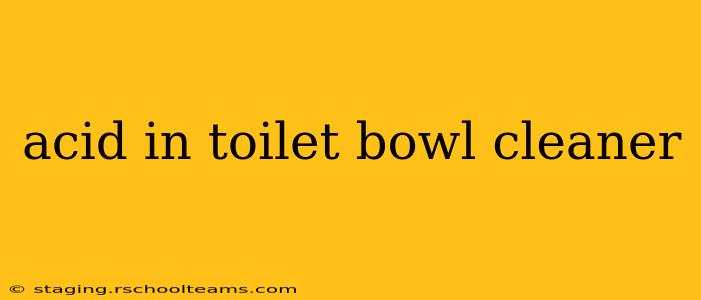Toilet bowl cleaners are designed to tackle tough stains and eliminate germs, and their effectiveness largely stems from the potent acids they contain. Understanding the types of acids used, their mechanisms of action, and the necessary safety precautions is crucial for safe and effective cleaning. This comprehensive guide delves into the science behind these powerful cleaning agents, addressing common questions and concerns.
What Acid is in Toilet Bowl Cleaner?
The most common acid found in toilet bowl cleaners is hydrochloric acid (HCl), also known as muriatic acid. This strong acid is highly effective at dissolving mineral deposits like limescale (calcium carbonate) and rust, which are frequent culprits behind toilet bowl stains and buildup. However, some toilet bowl cleaners utilize other acids, depending on the specific formulation and intended purpose. These can include:
- Sulfamic acid: This is a less corrosive alternative to hydrochloric acid, making it a popular choice in some formulations, particularly those marketed as gentler on plumbing. It's effective against mineral deposits and is often preferred for its lower risk of damage to porcelain.
- Phosphoric acid: While less common in modern formulations due to environmental concerns, phosphoric acid can still be found in some toilet bowl cleaners. It's also effective at dissolving mineral deposits.
The specific acid and its concentration will vary between brands and product types, so always refer to the product label for detailed information.
Is Toilet Bowl Cleaner Acidic or Basic?
Toilet bowl cleaners are definitively acidic. Their low pH levels are what enables them to effectively dissolve mineral deposits, which are typically basic or alkaline in nature. The acidity is what makes them powerful cleaning agents, but also requires careful handling.
What are the Dangers of Toilet Bowl Cleaner?
The strong acids in toilet bowl cleaners pose several dangers if not handled correctly:
- Chemical burns: Contact with skin or eyes can cause severe burns. Always wear appropriate protective gear, including gloves and eye protection, when handling these products.
- Inhalation hazards: The fumes produced by toilet bowl cleaners can be irritating to the respiratory system. Ensure adequate ventilation when using them.
- Ingestion: Accidental ingestion can be extremely dangerous and potentially fatal. Keep toilet bowl cleaners out of reach of children and pets.
- Mixing with other cleaners: Never mix toilet bowl cleaner with other cleaning products, particularly those containing bleach. This can create toxic gases, leading to serious health consequences.
Always follow the manufacturer's instructions carefully and heed all safety warnings.
How Does Acid Toilet Bowl Cleaner Work?
Acidic toilet bowl cleaners work by a chemical reaction known as neutralization. The acid in the cleaner reacts with the alkaline mineral deposits (like limescale) in the toilet bowl. This reaction produces a salt and water, effectively dissolving the deposits and leaving a cleaner surface.
Is it Safe to Mix Toilet Bowl Cleaner with Bleach?
Absolutely not. Mixing toilet bowl cleaner (which contains acid) with bleach is extremely dangerous and should never be done. This combination can produce chlorine gas, a highly toxic and potentially lethal gas.
What Happens If You Mix Toilet Bowl Cleaner and Bleach?
Mixing toilet bowl cleaner and bleach can result in the formation of chlorine gas, a highly toxic and potentially lethal gas. Symptoms of chlorine gas exposure include coughing, shortness of breath, chest pain, and eye irritation. In severe cases, it can lead to lung damage and even death. Never mix these two products.
How to Safely Use Toilet Bowl Cleaner?
Safe usage involves several key steps:
- Ventilation: Always ensure good ventilation in the bathroom.
- Protective Gear: Wear rubber gloves and eye protection.
- Follow Instructions: Carefully read and follow the manufacturer's instructions on the product label.
- Dilution (if applicable): Some cleaners require dilution; follow the instructions precisely.
- Proper Disposal: Dispose of used cleaner according to local regulations.
- First Aid: In case of accidental contact or ingestion, immediately seek medical attention.
By understanding the chemistry behind toilet bowl cleaners and following safety guidelines, you can effectively clean your toilet while minimizing risks to your health and the environment. Remember, safety should always be the priority when using any cleaning product.
